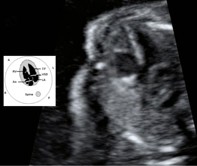Peer Reviewed
GP emergency management
Maternal distress: congenital cardiac defects on the morphological scan
Abstract
A 25-year-old pregnant women presents in distress after a cardiac defect is found on the morphological scan. What would you do next?
Key Points
- Always refer pregnant patients for nuchal translucency and morphological scans to radiologists who specialise in fetal medicine.
- The nuchal translucency scan is important, not just because of the early detection of chromosomal disorders but also because it may be abnormal in the presence of significant congenital abnormalities, especially those relating to the heart.
- The diagnosis of a fetal cardiac abnormality is an emotional emergency for the couple concerned and requires empathetic counselling and often referral to a psychosocial specialist.
- If fetal cardiac defects are noted, the patient needs an urgent assessment by a fetal medicine specialist with specific expertise in cardiology.
- There is a wide variation of abnormalities within the same congenital cardiac syndrome or condition, and each case should be approached individually.
- Always ask about a family history of congenital defects (especially cardiac), ideally at the preconception consultation but otherwise as soon as the pregnancy is confirmed.
- 22q11 deletion syndrome is one of the most common genetic conditions that are hereditary. It occurs in a wide range of clinical variations and may be underdiagnosed.
Purchase the PDF version of this article
Already a subscriber? Login here.

